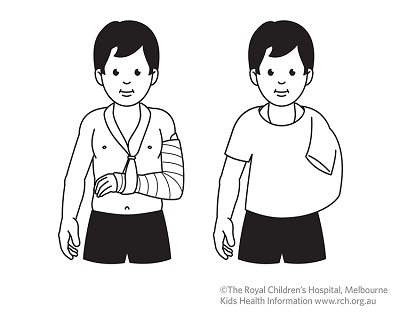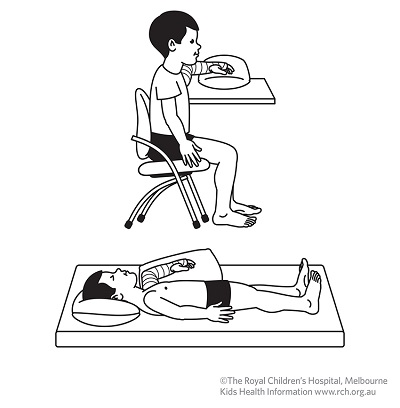If your child has a fracture just above their elbow, this is called a supracondylar elbow fracture.
Sometimes, supracondylar elbow fractures can be displaced, which means that the bones are out of alignment. If your child has a displaced fracture, they may need surgery to have pins inserted, which hold the bones in place while the fracture heals.
An undisplaced fracture means that the bone is still aligned.
For undisplaced and displaced fractures, your child will have a cast and a sling to support and protect the bone while it heals. The cast may be:
- a full cast – this is necessary after surgery
- a partial cast held in place with bandages – this is called a backslab.
The cast and sling are placed under loose clothing, and not passed through a sleeve.
This fact sheet provides information on what to do once your child has been treated in hospital for a supracondylar elbow fracture. If you think your child has a fracture and you are looking for first aid advice, see our fact sheet Fractures (broken bones).

Care at home
Fractures are painful. Although immobilising the arm with the cast and sling will help to reduce the pain, additional pain relief (e.g. paracetamol) is often needed. Give the pain relief medication regularly for the first few days, following the directions
on the packet, or as directed by the doctor.
Elevate the elbow
During the first few days, it is important for your child to rest as much as possible with their elbow and hand elevated on pillows. The hand should be higher than the elbow. This will help to minimise swelling of the elbow, hand and fingers.

Use an arm sling for as long as directed by your child’s doctor, but it can be removed when your child is lying down. Encourage your child to bend and straighten their fingers regularly, and make sure you check their fingers for movement, feeling and
circulation.
Skin care
Itching under the cast is common. Make sure your child avoids scratching inside the cast as this may damage the skin and cause infection. Do not let them push any object inside the cast (e.g. don’t allow them to use a ruler to scratch inside the cast).
Never cut or attempt to modify the cast or bandage.
While it may be tempting to remove the backslab for brief periods, it is recommended that you leave it in place.
You can help relieve itch by using a hair-dryer to blow cold air into the cast (do not use warm or hot air as this can burn the skin or warp the cast). Antihistamines may be useful for reducing the itch. Talk to your local pharmacist about a suitable
antihistamine medication to use.
Cast care
If your child has a plaster cast, it is important to keep it clean and dry. For showering or bathing, seal the cast in a plastic bag with tape or a rubber band. Never allow your child to immerse the cast in water, even if it is in a plastic bag. For more
information, see our fact sheet
Plaster cast care.
Even though fibreglass casts are waterproof, you need to make sure the padding underneath stays dry. If your child has a fibreglass cast, treat it as though it is a plaster cast and avoid getting it wet.
When to see a doctor
Severe pain and swelling, change in the colour of the fingers (white or blue), numbness or pins and needles, and inability to move the fingers are signs that the arm has not been elevated properly (with the hand above the elbow) or that your child's cast
may be too tight.
If any of these signs occur, rest and elevate the arm for 30 minutes. If the swelling or pain improves, make sure that your child is wearing their sling correctly, with the hand higher than the elbow.
After elevating the arm for 30 minutes, take your child to the hospital emergency department immediately if:
- the fingers remain very swollen
- the fingers remain white or blue
- your child complains of pins and needles or numbness in the fingers
- your child is not be able to move their fingers, or complains of pain when you move them
- your child has severe pain that is not relieved by the recommended medication at the recommended dose.
Take your child to your GP or local hospital if:
- the cast is cracked, soft, loose or tight, or has rough edges that hurt
- you are worried that an object has been pushed inside the cast
- there is a bad smell or ooze coming from the cast
- your child is in increasing pain.
Follow-up
Displaced fractures: Your child will have an X-ray and review by the doctor one week after the injury. The next review will usually be three weeks after the injury.
If your child had pins placed in the bones, your child’s doctor will explain how and when these are removed. See our fact sheet
Removal of metalware.
Another follow-up appointment and X-ray will be arranged for six weeks after the injury.
Undisplaced fractures: Your GP can review your child three weeks after the injury, and remove the backslab. An X-ray is not required.
After the cast is removed
When the cast is removed, the skin may be dry and itchy. Bathe with warm water and soap, and apply a gentle, non-perfumed moisturiser.
Your child should begin moving their elbow. Their elbow will usually be stiff for a several months after the cast is removed. Full mobility will return with time, but this may take up to one year. Physiotherapy is not recommended.
Your child should avoid sports and heavy arm use (such as climbing) for one month after removal of the cast. Ask your doctor if you are unsure whether your child is ready to return to sports.
Take your child to your GP if you are concerned about:
- the shape of your child’s arm
- the way they are using their arm.
Key points to remember
- A supracondylar elbow fracture is a fracture just above the elbow. The fracture may be displaced (where the bones are out of alignment) or undisplaced.
- Displaced fractures may require surgery to put pins in the bones to hold them in place.
- A supracondylar elbow fracture will require cast and sling while the fracture heals. If surgery was required, the cast will be a full cast. If surgery was not required, it will be a backslab (partial cast with bandages).
- Your child should elevate their arm for the first few days after the injury. The hand should be above the height of the elbow.
- Ensure your child avoids scratching inside the cast and do not let them push any object inside the cast.
- Seek urgent medical attention if after elevating the arm for 30 minutes your child still shows signs that the cast is too tight.
- Avoid sports and heavy arm use for one month after removal of the backslab.
For more information
Common questions our doctors are asked
Why doesn’t my child need an X-ray at their follow-up
appointment?
If your child has had an undisplaced fracture, there is no need for an X-ray at the follow-up appointment because supracondylar fractures almost always heal by themselves. We always try to minimise X-ray exposure in children when possible.
Do the follow-up appointments need to be at the hospital
where my child was originally treated?
No – you can have your follow-up appointments at a local hospital or medical centre that is equipped to manage fractures. Your doctor will be able to help you find an appropriate place for a follow-up appointment.
Call an ambulance (000) immediately in an emergency.
Developed by The Royal Children's Hospital Orthopaedics department. We acknowledge the input of RCH consumers and carers.
Reviewed November 2018.
This information is awaiting routine review. Please always seek the most recent advice from a registered and practising clinician.